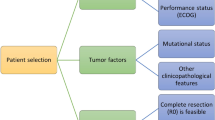Abstract
Background
There are few detailed clinical reports about perihepatic lymph node (LN) assessment of hepatocellular carcinoma (HCC). The purpose of the present study was to evaluate the incidence, site, and impact on survival of LN metastasis in patients with HCC amenable to curative liver resection and routine regional lymphadenectomy.
Methods
From January 2001 to June 2004, a total of 523 HCC patients undergoing curative hepatic resection and routine regional lymphadenectomy were included in this study. The incidence, site of LN metastasis in HCC patients, and its influence on survival were analyzed.
Results
A total of 3433 lymph nodes were dissected from the 523 patients enrolled in this study and examined by pathologists. Among these patients, LN metastasis was found in 39 (7.45%) patients. Hepatic pedicle, retropancreatic space, and common hepatic artery stations were conventionally removed. The incidence of LN metastasis in the hepatic pedicle station was higher than that in the other stations (p < 0.01) The overall cumulative survival rate was significantly worse for patients with LN metastasis than for those without LN metastasis (p < 0.01). The median survival time was 28 months among the patients with LN metastasis and 53 months among those without LN metastasis. Tumors had recurred in 82.05% (32/39) of patients with LN metastasis and in 57.64% (279/484) of those without LN metastasis (p < 0.01). Regional lymphadenectomy was considerably safe with a low intraoperative complication rate (0.95%).
Conclusions
Lymph node metastasis in patients with HCC is closely related to a lower survival rate. Regional lymph node dissection should always be performed to determine the precise stage of the disease. Hepatic resection with regional lymphadenectomy is a safe procedure in patients with HCC.

Similar content being viewed by others
References
Parkin DM, Bray F, Ferlay J et al (2001) Estimating the world cancer burden: Globocan 2000. Int J Cancer 94:153–156
Ferlay J, Bray F, Pisani P, et al (2001) 2000: Cancer incidence, mortality and prevalence worldwide. Version 1.0. IARC Press, Lyon
Hao XS, Wang PP, Chen KX et al (2005) Twenty-year trends of primary liver cancer incidence rates in an urban Chinese population. Eur J Cancer Prev 12:273–279
Hao XS, Chen KX, Wang PP et al (2005) Changes in survival patterns in urban Chinese patients with liver cancer. World J Gastroenterol 9:1212–1215
Sobin LH, Wittekind C (eds) (2001) International union against cancer (UICC): TNM classification of malignant tumors, 5th edn. New York, Wiley
Mitchell JD, Mathinsen DJ, Wright CD et al (2001) Resection for bronchogenetic carcinoma involving the carina: long-term results and effect of nodal status on outcome. J Thorac Cardiovasc Surg 121:465–471
Hsu CP, Chen CY, Hsia JY et al (2001) Prediction of prognosis by the extent of lymph node involvement in squamous cell carcinoma of the thoracic esophagus. Eur J Cardiothorac Surg 19:10–13
Miyao N, Masumori N, Takahashi A et al (1998) Lymph node metastasis in patients with carcinomas of the renal pelvis and ureter. Eur Urol 33:180–185
Mincey BA, Bammer T, Atkinson EJ et al (2001) Role of axillary node dissection in patients with T1a and T1b breast cancer: Mayo Clinic experience. Arch Surg 136:779–782
Manzoni G, Verlato G, Guglielmi A et al (1996) Prognostic significance of lymph node dissection in gastric cancer. Br J Surg 83:1604–1607
Nelson H, Petrelli N, Carlin A et al (2001) Guidelines 2000 for colon and rectal cancer surgery. J Natl Cancer Inst 93:583–596
Farnell MB, Nagorney DM, Sarr MG (2001) The Mayo Clinic approach to the surgical treatment of adenocarcinoma of the pancreas. Surg Clin North Am 81:611–623
Shimada H, Endo I, Togo S et al (2001) The role of lymph node dissection in the treatment of gallbladder carcinoma. Cancer 79:892–899
Kitagawa Y, Nagino M, Kamiya J et al (2001) Lymph node metastasis from hilar cholangiocarcinoma: audit of 110 patients who underwent regional and paraaortic node dissection. Ann Surg 233:385–392
Shimada M, Yamashita Y, Aishima S et al (2001) Value of lymph node dissection during resection of intrahepatic cholangiocarcinoma. Br J Surg 88:1463–1466
Rassi E, Partensky C, Scoazec JY et al (1999) Peripheral cholangiocarcinoma: presentation, diagnosis, pathology and management. Eur J Surg Oncol 25:375–380
Qiang L, Huikai L, Butt K et al (2006) Factors associated with disease survival after surgical resection in Chinese patients with hepatocellular carcinoma. World J Surg 30:439–445
Japanese Society of Biliary Surgery (2001) General rules for surgical and pathological studies on cancer of biliary tract, 4th edn. Kanehara, Tokyo
Fleming ID, Cooper JS, Henson DE et al (eds) (2001) American joint committee on cancer staging manual, 5th edn. Lippincott, Philadelphia, pp 97–101
Abe T, Furuse J, Yoshino M et al (2002) Clinical characteristics of hepatocellular carcinoma with an extensive lymph node metastasis at diagnosis. Am J Clin Oncol 25:318–323
Ercolani G, Grazi GL, Ravaioli M et al (2004) The role of lymphadenectomy for liver tumors: further considerations on the appropriateness of treatment strategy. Ann Surg 239:202–209
Liver Cancer Study Group of Japan (1990) Primary liver cancer of Japan: clinicopathological features and results of surgical treatment. Ann Surg 211:277–287
Acknowledgments
This study was supported by the Department of Hepatobiliary Surgery, Cancer Hospital of Tianjin Medical University. The authors thank the Epidemiology Unit of Tianjin Centre for Disease Control and Epidemiology Unit of Cancer Hospital of Tianjin Medical University for their technological support.
Author information
Authors and Affiliations
Corresponding author
Rights and permissions
About this article
Cite this article
Xiaohong, S., Huikai, L., Feng, W. et al. Clinical Significance of Lymph Node Metastasis in Patients Undergoing Partial Hepatectomy for Hepatocellular Carcinoma. World J Surg 34, 1028–1033 (2010). https://doi.org/10.1007/s00268-010-0400-0
Published:
Issue Date:
DOI: https://doi.org/10.1007/s00268-010-0400-0




